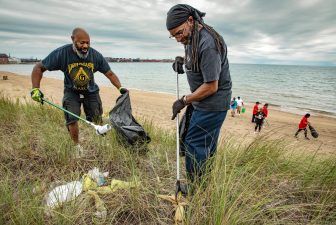
An Adopt-a-Beach volunteer removes a water bottle from a beach. Image: Lloyd DeGrane via Alliance for the Great Lakes
By Reese Carlson
Most of the litter on Great Lakes beaches is plastic, according to a 20-year study released Thursday.
The study, spanning 2003 to 2023, is based on trash collected during the Adopt-a-Beach volunteer clean-up program organized by the Alliance for the Great Lakes, a nonprofit group working to protect the Great Lakes. Volunteers each year clean up Great Lakes beaches in all eight Great Lake states.
As much as 86 percent of the trash collected by the alliance was plastic, said Olivia Reda, lead author of the report and the volunteer engagement manager for the group. Much of it is smaller than an inch square.
“We see that on average, 40 percent of the litter pieces fall into that category of tiny trash,” Reda said. “Our volunteers find many of those smaller pieces that can then break down into microplastics – which we are now drinking.”
More than 30 million people, or 10 percent of the U.S. population, rely on the Great Lakes for drinking water, according to the National Oceanic and Atmospheric Administration.
“Everyone should care about this, this is a matter of your personal health,” said Melissa Valliant, the communications director for Beyond Plastics, a nonprofit group aimed at ending plastic pollution. “Microplastics have been found in many things that we consume, including honey, beer, salts, fruits, veggies, seafood and meat. And now it’s been found in human placenta, blood, feces and so much more. We just consume so many microplastics on a daily basis.”

Two volunteers remove piles of littered trash from the beach. Photo: Lloyd DeGrane, courtesy of Alliance for the Great Lakes
Microplastics threaten human health. Exposure to them, especially when consumed, involve an array of toxic effects, including reproductive problems, delays in immune responses and oxidative stress, according to a 2023 study published in Environment and Health Journal.
The Alliance for the Great Lakes report lists the top 10 items that picked up by volunteers on the beach: cigarette butts, food wrappers, caps/lids, straws/stirrers, cigar tips, cups/plates/forks/knives, plastic beverage bottles, plastic bags, glass beverage bottles, beverage cans. About 27 percent was food related and 22 percent smoking related.
Most of these items are there because humans left them on the beach or they blew onto the beach from nearby, the report said. They are not unknown items that blew in from faraway places.
“Single-use plastics are what our volunteers find the most,” Reda said. “Those plastic water bottles, forks, straws, or whatever else just keep breaking down into smaller and smaller pieces.”
Other groups have made similar observations.
“These findings are consistent with what research has been coming from the Ocean Conservancy, (which does) these same kinds of clean-ups but in marine environments,” Valliant said. “This just shows how prevalent a problem this is, that we are getting the same results from international marine coastal cleanups as in the Great Lakes.”
The report calls for more individual, state and federal action. Individuals can only do so much, the report said. It called for more action from large corporations.
“No matter who you are, you are connected to this issue,” Reda said. “And the time to start caring is now.”